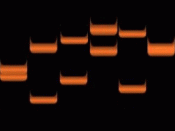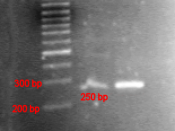Bio 181
Lap report#12
DNA is a hereditary double helix strands that present in the nucleus of living cells. DNA acts as the blueprint for all of the proteins synthesized by that cell. There are many chromosomal regions that vary widely between individuals called polymorphic DNA (poly="many", morph="form"). These regions may or may not encode proteins. By examining several of these polymorphic regions within a person's DNA, a DNA "fingerprint" is created for that person. Due to their unique characteristics, DNA fingerprints are widely used for determining paternity/maternity, kinship, identification of human remains, and the genetic basis of various diseases. It is most widely used for criminal forensics. DNA samples, obtained from small specimens of skin, blood, semen or hair roots collected at the crime scene, are treated with detergent to rupture cell membranes and obtain DNA for further analysis. DNA from a crime scene can be matched to a suspect, indicating that the suspect was indeed present at the scene of the crime.
PCR (polymerase chain reaction) is used to generate lots of DNA from a small sample called amplification. This DNA is then used to create DNA fingerprints.
Taq polymerases (enzymes that are originally purified from a bacterium and stable at very high temperature), primers (help amplify polymorphic regions of the DNA), and the treated DNA sample are mixed together and undergo PCR "cycles". Under denaturation, DNA is heated to separate the strands, cooled to allow the primers to bind to the DNA during annealing, and then heated again in primer extension step to allow the polymerase to create new DNA. The process is usually repeated for 20-30 cycles, amplifying the target sequence exponentially. The amplified DNA is then separated via gel electrophoresis to identify unique patterns.
Gel electrophoresis is the process by which the size of...


